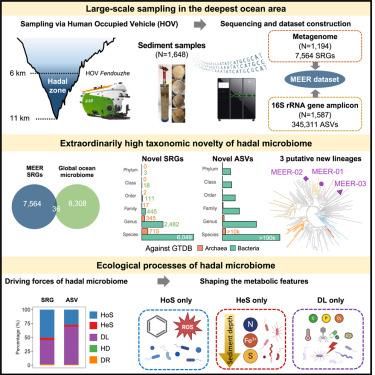Microbial ecosystems and ecological driving forces in the deepest ocean sediments
IF 42.5
1区 生物学
Q1 BIOCHEMISTRY & MOLECULAR BIOLOGY
引用次数: 0
Abstract
Systematic exploration of the hadal zone, Earth’s deepest oceanic realm, has historically faced technical limitations. Here, we collected 1,648 sediment samples at 6–11 km in the Mariana Trench, Yap Trench, and Philippine Basin for the Mariana Trench Environment and Ecology Research (MEER) project. Metagenomic and 16S rRNA gene amplicon sequencing generated the 92-Tbp MEER dataset, comprising 7,564 species (89.4% unreported), indicating high taxonomic novelty. Unlike in reported environments, neutral drift played a minimal role, while homogeneous selection (HoS, 50.5%) and dispersal limitation (DL, 43.8%) emerged as dominant ecological drivers. HoS favored streamlined genomes with key functions for hadal adaptation, e.g., aromatic compound utilization (oligotrophic adaptation) and antioxidation (high-pressure adaptation). Conversely, DL promoted versatile metabolism with larger genomes. These findings indicated that environmental factors drive the high taxonomic novelty in the hadal zone, advancing our understanding of the ecological mechanisms governing microbial ecosystems in such an extreme oceanic environment.

最深海洋沉积物中的微生物生态系统和生态驱动力
历史上,对地球最深的海洋领域——深海带的系统探索一直面临着技术上的限制。在马里亚纳海沟环境与生态研究(MEER)项目中,我们在马里亚纳海沟、雅普海沟和菲律宾盆地的6-11 km处收集了1648个沉积物样本。元基因组测序和16S rRNA基因扩增子测序生成了92 tbp的MEER数据集,包括7,564种(89.4%未报道),显示出较高的分类新颖性。与报道的环境不同,中性漂移的作用最小,而同质选择(HoS, 50.5%)和扩散限制(DL, 43.8%)成为主要的生态驱动因素。HoS倾向于具有hadal适应关键功能的流线型基因组,例如芳香化合物利用(寡营养适应)和抗氧化(高压适应)。相反,DL促进了更大基因组的多功能代谢。这些发现表明,环境因素驱动了hadal区高度的分类新颖性,促进了我们对极端海洋环境下微生物生态系统的生态机制的理解。
本文章由计算机程序翻译,如有差异,请以英文原文为准。
求助全文
约1分钟内获得全文
求助全文
来源期刊

Cell
生物-生化与分子生物学
CiteScore
110.00
自引率
0.80%
发文量
396
审稿时长
2 months
期刊介绍:
Cells is an international, peer-reviewed, open access journal that focuses on cell biology, molecular biology, and biophysics. It is affiliated with several societies, including the Spanish Society for Biochemistry and Molecular Biology (SEBBM), Nordic Autophagy Society (NAS), Spanish Society of Hematology and Hemotherapy (SEHH), and Society for Regenerative Medicine (Russian Federation) (RPO).
The journal publishes research findings of significant importance in various areas of experimental biology, such as cell biology, molecular biology, neuroscience, immunology, virology, microbiology, cancer, human genetics, systems biology, signaling, and disease mechanisms and therapeutics. The primary criterion for considering papers is whether the results contribute to significant conceptual advances or raise thought-provoking questions and hypotheses related to interesting and important biological inquiries.
In addition to primary research articles presented in four formats, Cells also features review and opinion articles in its "leading edge" section, discussing recent research advancements and topics of interest to its wide readership.
 求助内容:
求助内容: 应助结果提醒方式:
应助结果提醒方式:


